
The Gaslamp Quarter is a district of San Diego, California. It is a 16½ block historical neighborhood in Downtown San Diego, and is the site of several entertainment and night life venues, as well as scheduled events and festivals, including Mardi Gras in the Gaslamp, Street Scene Music Festival, Taste of Gaslamp and ShamROCK, a St. Patrick's Day event. Petco Park, home of the San Diego Padres is located one block away in downtown San Diego's East Village.

Downtown Pittsburgh, colloquially referred to as the Golden Triangle, and officially the Central Business District, is the urban downtown center of Pittsburgh. It is located at the confluence of the Allegheny River and the Monongahela River whose joining forms the Ohio River. The "triangle" is bounded by the two rivers. The area features offices for major corporations such as PNC Bank, U.S. Steel, PPG, Bank of New York Mellon, Heinz, Federated Investors and Alcoa. It is where the fortunes of such industrial barons as Andrew Carnegie, Henry Clay Frick, Henry J. Heinz, Andrew Mellon and George Westinghouse were made. It contains the site where the French fort, Fort Duquesne, once stood.

Massachusetts Avenue is a major diagonal transverse road in Washington, D.C., and the Massachusetts Avenue Historic District is a historic district that includes part of it.

The Bartow Downtown Commercial District is a historic district in central Bartow, Florida. Composed of an area bounded by Davidson and Summerlin Streets and Broadway and Florida Avenues, the district includes twenty-one contributing properties. It was added to the National Register of Historic Places in 1993.

There are 297 properties and districts listed on the National Register of Historic Places in Denver, the capital of the U.S. state of Colorado.

The Cotaco Opera House, also known as Masonic Building, was the first opera house constructed in the state of Alabama. It is located at 115 Johnston Street in historic downtown Decatur, Alabama.

Victor Downtown Historical District is a 22 acres (8.9 ha) historic district encompassing several blocks of Victor, Colorado which was listed in the National Register of Historic Places in 1985. The listing included 55 contributing buildings out of 66 buildings in total. The district is bounded roughly by Diamond Avenue, Second, Portland and Fifth Streets.

Glasco Downtown Historic District is an early commercial, Italianate historic shopping area located in Glasco, Kansas that is listed on the National Register of Historic Places. The 3.9-acre (1.6 ha) historic district runs roughly along Main Street from Railroad Avenue to Fisher Street and continues along Railroad Avenue and Fisher Streets between Main and Buffalo Streets in Glasco. It includes 22 buildings deemed to contribute to the historic character of the area, one other contributing structure, and six non-contributing buildings.
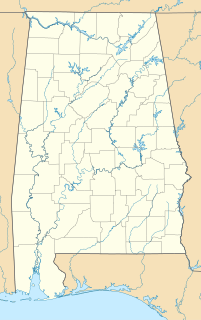
The Church Street East Historic District is a historic district in the city of Mobile, Alabama, United States. It was placed on the National Register of Historic Places on 16 December 1971. Since a boundary increase on 13 January 1984, it is roughly bounded by Broad, Conti, Water, Claiborne, and Canal Streets. 20 April 2005 saw the further addition of 66 & 68 Royal Street to the district. The district covers 1,403 acres (5.68 km2) and contains 83 contributing buildings and one object. It contains portions of Mobile's 19th century downtown area and features government, museum, commercial, and residential structures in a variety of 19th-century styles. The buildings range in age from the 1820s to 1900 and include the Federal, Greek Revival, Renaissance Revival, Italianate, and various other Victorian architectural styles. Notable buildings include the Government Street Presbyterian Church, Barton Academy, and the Ketchum House.

The Old Dauphin Way Historic District is a historic district in the city of Mobile, Alabama, United States. It was named for Dauphin Way, now known as Dauphin Street, which bisects the center of the district from east to west. The district is roughly bounded by Broad Street on the east, Springhill Avenue on the north, Government Street on the south, and Houston Avenue on the west. Covering 766 acres (3.10 km2) and containing 1466 contributing buildings, Old Dauphin Way is the largest historic district in Mobile.

The Fort Madison Downtown Commercial Historic District has a collection of late-19th century store fronts centered on Ave. G, from 6th to 9th Street, and Ave. H from 7th to 9th, in Fort Madison, Iowa. It was listed on the National Register of Historic Places in 2007.
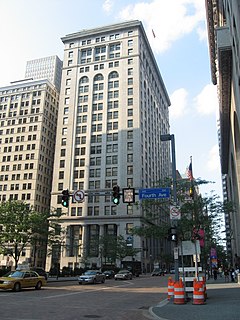
The Pittsburgh Central Downtown Historic District is a historic district in the Central Business District of Pittsburgh, Pennsylvania, United States. Bounded by Wood Street, Forbes Avenue, Grant Street, and Liberty Avenue, it was listed on the National Register of Historic Places on December 17, 1985.
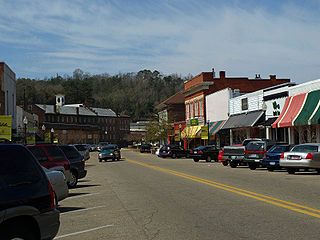
The Daniel Pratt Historic District is a historic district that includes 140 acres (57 ha) and 154 buildings in Prattville, Alabama. It is named in honor of Prattville's founder, Daniel Pratt. The district includes the historic downtown and is roughly bounded by 6th Street in the north, Northington Street in the east, 1st Street in the south, and Bridge and Court streets in the west. Architecture in the district includes the Greek Revival, Italianate, and Bungalow styles. It was listed on the National Register of Historic Places on August 30, 1984.

The Court Square–Dexter Avenue Historic District is a 17.6-acre (7.1 ha) historic district in downtown Montgomery, Alabama. Centered on the Court Square Fountain, the district includes twenty-seven contributing buildings and two objects. It is roughly bounded by Dexter Avenue, Perry, Court and Monroe streets. Architectural styles in the district include Italianate, Late Victorian, and various Revival styles. It was placed on the National Register of Historic Places on March 1, 1982. The boundaries were subsequently increased on August 30, 1984.

The Dowe Historic District is a 1-acre (0.40 ha) historic district in Montgomery, Alabama. It includes 320 and 334 Washington Avenue and 114–116 South Hull Street. The architectural style of the four contributing buildings ranges from Greek Revival to Queen Anne. The district was placed on the National Register of Historic Places on December 29, 1988.

The Garden District is a 315-acre (127 ha) historic district in Montgomery, Alabama.
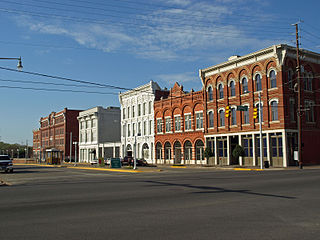
The Lower Commerce Street Historic District is a 45-acre (18 ha) historic district in the old commercial district of Montgomery, Alabama. It includes fifty-two contributing buildings. It is roughly bounded by the Central of Georgia railroad tracks, North Lawrence Street, Madison Avenue, and Commerce Street. Architectural styles in the district include the Italianate, Classical Revival, and Renaissance Revival. It was placed on the National Register of Historic Places on March 29, 1979, the boundaries were subsequently increased on February 25, 1982 and January 15, 1987.

Barr's Subdivision Historic District is a historic district in Citronelle, Alabama, United States. It is roughly bounded by U.S. Route 45 and Howard Avenue between LeBaron Avenue and State Street. The district covers 5.9 acres (0.024 km2) and contains 7 contributing properties. It was placed on the National Register of Historic Places on July 7, 2005.
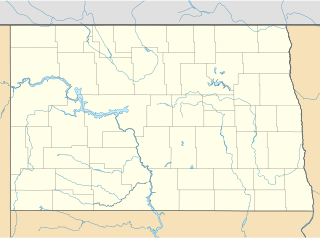
Downtown Fargo District, or Downtown Fargo Historic District, is a historic district in Fargo, North Dakota that was listed on the National Register of Historic Places in 1983.

The Jackson Historic District is a historic district in the city of Jackson, Alabama. Jackson was founded in 1816 and is the oldest incorporated settlement in Clarke County. The historic district features examples of Greek Revival, Queen Anne, Colonial Revival, and regional vernacular architecture. Spread over 180 acres (73 ha) with 140 contributing buildings, it is roughly bounded by College Avenue, Forest Avenue, Carroll Avenue, Cedar Street, Florida Street, Commerce Street, Clinton Street, and Spruce Street. It is a part of the Clarke County Multiple Property Submission and was placed on the National Register of Historic Places on January 23, 1998.























